Continental Drift: The Moving Continents
We all have seen the world map and have used it for our various applications e.g. to locate a country or a city etc. We see large land masses that we know as continents surrounded by vast oceans. Have you ever noticed that some of the coastlines fit distant landmasses perfectly like a jigsaw puzzle? For example, the eastern coast of South America fits perfectly into the western coast of Africa. It points to a possibility that these two landmasses once might have been joined together to form a larger landmass in the distant past of earth's early age.
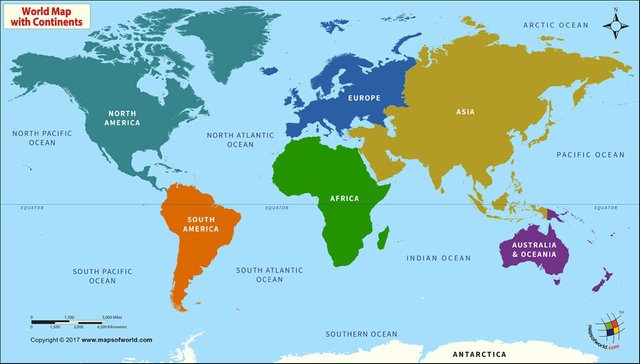
This idea was first observed by a German meteorologist named Alfred Wegener in 1912. As a meteorologist, Wegener had to observe the map most of the time. At this point, he observed such patterns on the surface of the earth. He came up with an idea to explain this. He proposed that all the continents of the world once were the part of a supercontinent he named as, Pangaea(Greek for "Entire Earth") over 250 million years ago and from this supercontinent, the continents of today separated and drifted slowly in various directions to their current day positions. He said the continents are moving. In this whole timeline many new continents were formed(e.g. Eurasia, Laurasia, Gondwana Land) and finally reached the present day world. It is a continuous process and the continents are still moving reshaping our world. Wegener named his theory as the Continental Drift Theory.
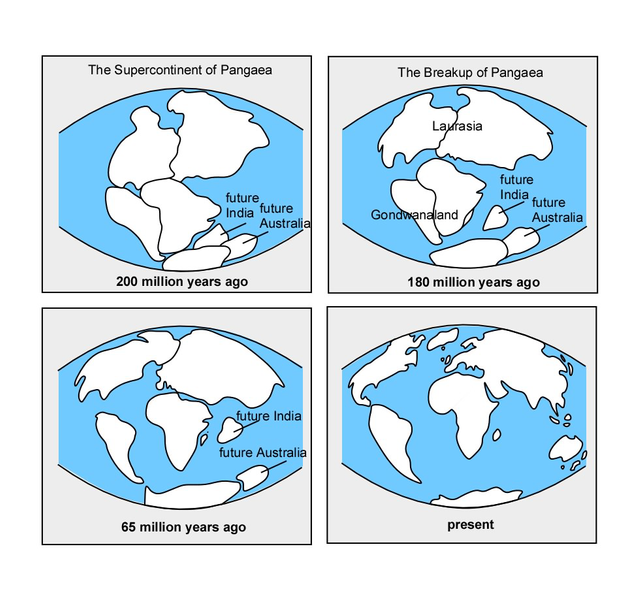
At that time people didn't believe in his idea. So Wegener came up with evidence to support his idea:
The Fitting Coastlines Like Jigsaw-Puzzle
As we discussed above, some of the continents' coastlines appear to fit perfectly to the coastlines of another continent. We notice it in the World map shown above. Wegener suggested that this may not be a mere coincidence. In fact, many other locations seem to have the similar patterns. However, it needs more evidence to support this idea.
Fossil Similarity Found in Different Continents
Millions of years ago when human life had yet not born on earth, life forms of different traits and forms lived on earth which are all extinct now due to some natural disasters that swept these entire species from earth. Their body remains underwent natural preservation in the form of fossils.
A diverse range of reptiles known as Dinosaurs lived on earth. Mesosaurus is a species of dinosaur which lived in shallow freshwater only. What Wegener read in books is that the fossils of Mesosaurs are only found in the eastern coast of South America and West coast of Africa. Wegener said that this fact has an important conclusion and aids as an major evidence to his theory. Millions of years ago, these two lands were connected with no sea or ocean between them. Mesosaurus lived in this merged land. In later times these species went extinct due to some unknown reasons and their bodies were engraved inside the rocks that we today know as fossils. When these two lands separated, they carried with them these fossils to their present locations. Similar distributions of some other lives such as Cynognathus, Lystrosaurus are also found in other places on earth pointing towards what Wegener had proposed.
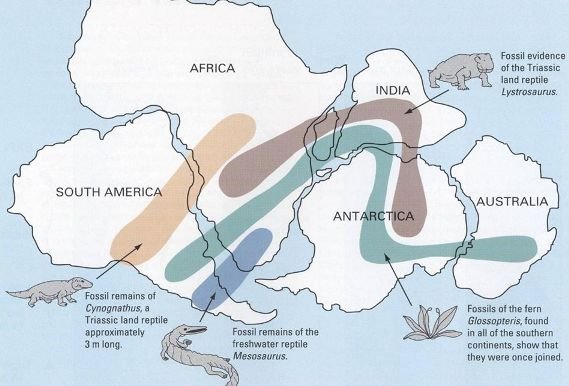
Identical Rocks and Mountains in Two Different Continents
It is found that the mountains in north-eastern America(USA) and that in northern Europe are made up of the same type of the rocks. Many other mountain ranges around the world show a similar distribution. It might be the case that these mountains were once in the same location and when the lands separated they tore the mountains apart and they moved to their present-day locations.
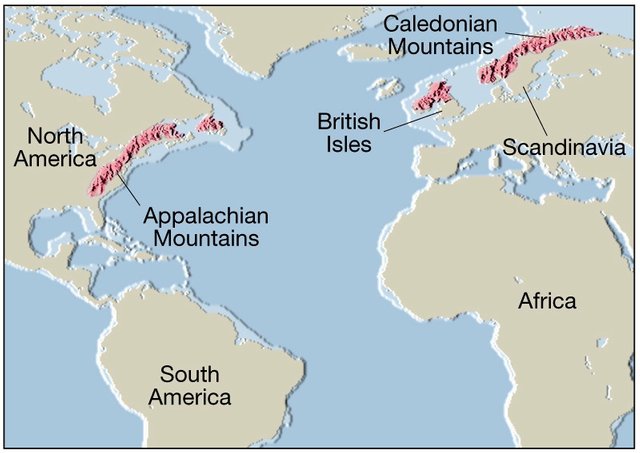
Glacial Striation
Glaciers are massive ice-pieces that are found on the top of some mountains and in the pole regions. It is well known fact that glaciers move. While moving they leave traces in the form of scratch patterns on rocks. This phenomenon of glaciers leaving traces in the process of moving is known as Glacial Striation. The noticeable thing is that such patterns are found on the bedrocks found in some tropical regions around the world. This suggests that some tropical regions may not have been tropical always. These tropical regions were once located in the polar regions from where they drifted to present day locations.
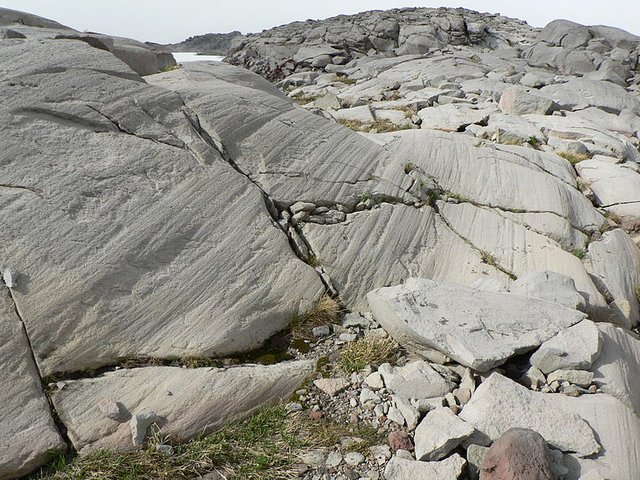
Coal Deposits in Polar Regions
We know that coal is a fossil fuel formed by the compression of dead plants far down below the ground by the extreme pressure from the upper earth matters over millions of years. Coal deposits are found in various regions around the globe like USA, Australia, Southern Africa and various places in Europe and Asia. What is surprising is that such coal deposits are also found in polar regions where no plants can grow. It points to what Wegener says. What is today known as the polar region may have been located somewhere else from where they drifted over millions of years to the present day location.
In his book entitled, "The Origin of Continents and Oceans" published in 1915 he put up all these evidence to support his theory. The unfortunate tragedy for Wegener is that he couldn't explain, "Why continents move?", "What drives the continental drift?". His theory remained unanswered until the Plate Tectonic theory was developed in around the 1950s. Plate Tectonic Theory along with many other discoveries proved that Wegener was in fact right all along and these two theories have been the two pivots of geological study around the world. I will discuss the Plate Tectonics in my upcoming post.
While in an expedition to snow-covered Greenland in 1930s with a purpose to measure the thickness of Greenland ice sheet and to study the year-round Arctic weather, Wegener died due to exposure to extreme cold in a tragic condition. His body is still there buried 100 meters beneath the ice. Sad thing is that he died long before his theory was scientifically accepted.

Wegener's theory brought into light that the earth is not a stable place. The continents are moving and will be moving till the existence of earth. That is nature. Millions of years from now, the ground on which we are standing now will be somewhere else. A new continent will come into existence. The ocean waves will touch new shores.
References:
- Youtube: Continental Drift: Link
- Live Science: Continental Drift: Theory & Definition: Link
- Allen Institute for Artificial Intelligence: Continental Drift: Link
- Scientus.org: Wegener and Continental Drift Theory: Link
- Youtube: Continents Adrift An Introduction to Continental Drift and Plate Tectonics: Link
I hope you loved reading my content. Please follow me @rupamxanu.
Thank you steemstem.
I live in Oregon. I been at my property since 1998 19 years here and I've noticed that things are changing here. I live near The Ring of Fire the east side of the Cascade Range. When we first moved here I took a lot of pictures of our property. We have a great 360 view here I can see from Mt.Bachlor to Mt Hood. I've noticed that Mt. Hood is reviling itself more and more. I just use to see the main pinnacle only. Now I see the bottom pinnacle. So it is moving a pretty darn fast. Your post is right on. The whole world is moving, changing, growing. We will see alot more before this generation is gone.
Is it so? Is it that much visible in terms of "years"?
Thumbs up, this is educative. The jigsaw fits indeed